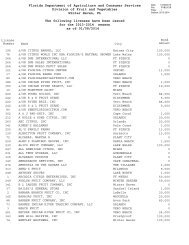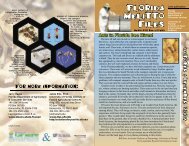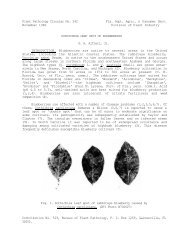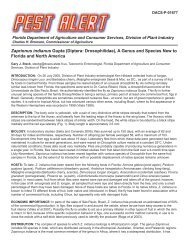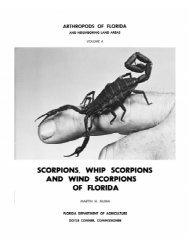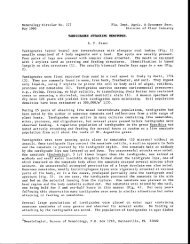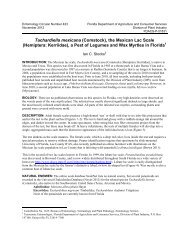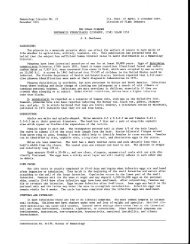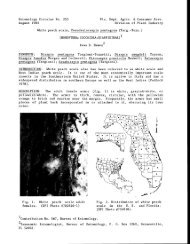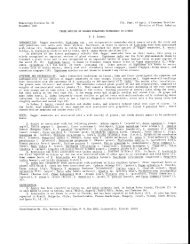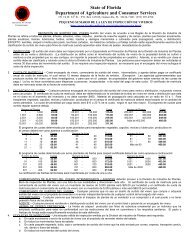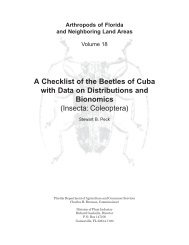2012 - Florida Department of Agriculture and Consumer Services
2012 - Florida Department of Agriculture and Consumer Services
2012 - Florida Department of Agriculture and Consumer Services
You also want an ePaper? Increase the reach of your titles
YUMPU automatically turns print PDFs into web optimized ePapers that Google loves.
Annual Report <strong>2012</strong><br />
July 1, 2011 – June 30, <strong>2012</strong><br />
Bureau <strong>of</strong> Citrus Budwood Registration<br />
Michael Kesinger, Chief<br />
Graft-transmissible diseases <strong>of</strong> citrus are incurable in commercial citrus groves; therefore, the use <strong>of</strong> certified budwood is the only<br />
option for nurserymen to grow productive disease-free trees. The Bureau <strong>of</strong> Citrus Budwood Registration makes certain that<br />
nurseries get a clean start, with outst<strong>and</strong>ing selected stock that has been rigorously tested <strong>and</strong> made available for distribution from<br />
foundation mother trees.<br />
This was a good year for budwood cutting at the Chiefl<strong>and</strong> foundation, as dem<strong>and</strong> continues to increase. Budwood cutting increased<br />
by 34%, to 515,007 bud eyes cut, in this fifth year <strong>of</strong> budwood distribution. Chiefl<strong>and</strong> foundation budwood represents 13% <strong>of</strong> the<br />
industry’s total source material used by citrus nurseries. The customer base includes 34 commercial citrus nurseries <strong>and</strong> 3 research<br />
agencies. Budwood was cut on 121 days for 238 separate customer orders. One hundred forty-two varieties were utilized for<br />
nursery propagation. Revenue from budwood sales at Chiefl<strong>and</strong> amounted to $119,926. A total <strong>of</strong> 1,316,197 bud eyes were cut <strong>and</strong><br />
distributed in Chiefl<strong>and</strong>’s first five years <strong>of</strong> existence.<br />
The Chiefl<strong>and</strong> greenhouses contain 1,105 trees, representing 309 varieties which includes 390 clones. The actual number <strong>of</strong> trees<br />
was reduced this year, as some <strong>of</strong> the closer-spaced trees were removed to allow more growing room. Fifty-four new trees were<br />
planted this year, representing 28 cultivars. Since the greenhouses are reaching capacity, <strong>and</strong> very little room is left for accepting<br />
new varieties, an expansion is planned for next fiscal year. Four <strong>of</strong> the original bows are to be extended 96 feet to the west, in the<br />
summer <strong>of</strong> <strong>2012</strong>. This will add 11,520 sq. ft. to the greenhouses.<br />
<strong>Florida</strong> breeders entered 48 new selections into the bureau’s parent tree indexing program, in Winter Haven, for testing <strong>and</strong> shoot-tip<br />
grafting. A total <strong>of</strong> 72 new introductions were received in Winter Haven in 2011-<strong>2012</strong>, sixty-one were released, <strong>and</strong> 19 were sent to<br />
Chiefl<strong>and</strong> for incorporation into the foundation.<br />
The bureau laboratory in Winter Haven ran 27,819 qPCR tests for eleven different citrus pathogens. To date citrus greening has not<br />
been found in any budwood source trees. This is a testimony to the efficacy <strong>of</strong> insect pro<strong>of</strong>ing <strong>of</strong> industry greenhouses, stringent<br />
spray programs <strong>and</strong> detailed inspections. A new robotic system has been acquired for the lab, that will increase efficiency in qPCR<br />
set up. A second robotic h<strong>and</strong>ler is scheduled for purchase in the next fiscal year, which will be programmable for reconfiguring<br />
qPCR plates.<br />
Major improvements were made to the bureau pathogen indexing greenhouses at Winter Haven this fiscal year. Five greenhouses<br />
were connected with an internal entry vestibule that allows employees access to the greenhouses without having to make multiple reentries.<br />
Insect exclusion was also improved by changing ro<strong>of</strong>s <strong>and</strong> sidewalls to polycarbonate. Cooling <strong>and</strong> heating systems were<br />
upgraded as well. All the renovation work was accomplished with a federal Clean Plant Network grant.<br />
The largest number <strong>of</strong> <strong>Florida</strong> citrus nursery propagations was reported this year since the m<strong>and</strong>atory greenhouse growing <strong>of</strong> nursery<br />
trees began in 2007. Citrus nursery propagation figures increased 25.7% from last year to 3,941,049 trees. The actual number <strong>of</strong><br />
trees that make it to commercial groves is considerably lower, as the propagation figures also represent trees for the homeowner<br />
market. An estimated 6 to 12% <strong>of</strong> the commercial citrus nursery stock is produced for the dooryard market.<br />
The budwood <strong>of</strong>fice processed 937 bud cutting reports, which amounts to an increase <strong>of</strong> 153 reports from the previous year. The<br />
average nursery made over 83 thous<strong>and</strong> propagations this fiscal year. One hundred eighty-two different clones, representing 147<br />
different varieties, were propagated this fiscal year. Although the citrus industry utilizes only a h<strong>and</strong>ful <strong>of</strong> varieties in commercial<br />
plantings, the dooryard (homeowner) market utilizes a larger assortment <strong>of</strong> citrus types.<br />
Sweet orange propagations accounted for 3.1 million trees, or 80.5% <strong>of</strong> the nursery stock produced. Grapefruit accounted for<br />
369,924 propagations, or 9.4% <strong>of</strong> the total production, compared to 7.3% last year. M<strong>and</strong>arins accounted for 287,778 propagations,<br />
or 7.3% <strong>of</strong> the total production. Lemons <strong>and</strong> Limes accounted for 1.5 <strong>of</strong> the nursery stock, with Pummelos at .2%.<br />
Hamlin <strong>and</strong> Valencia were the top two varieties propagated, making up 34.6 <strong>and</strong> 34.2% <strong>of</strong> nursery propagations, respectively.<br />
Midsweet was the third most popular variety, at 7.5% <strong>of</strong> nursery propagations, followed by Ray Ruby grapefruit at 4.6%, Navels at<br />
3%, <strong>and</strong> Ruby Red grapefruit at 2.7%. Orri was the most popular m<strong>and</strong>arin type propagated at 38,731 propagations, followed<br />
closely by Tango at 35,138. This is the first time in years that the traditional m<strong>and</strong>arin types have been replaced by relative<br />
newcomers. Swingle was the most popular rootstock used for budding. This is the 24th year that Swingle has been the top-utilized<br />
rootstock. Nursery trees on Swingle account for 37 % <strong>of</strong> all propagations, compared to 40% last year. Kuharske citrange <strong>and</strong> Sour<br />
Orange were the 2nd <strong>and</strong> 3rd most utilized rootstocks, accounting for 17% <strong>and</strong> 8% <strong>of</strong> propagations, respectively. Carrizo citrange,<br />
along with X-639, were the next most popular rootstocks, at 7.9 <strong>and</strong> 7.6 % respectively, followed by Volkamer at 4.5%, Cleopatra at<br />
3.3% <strong>and</strong> US-802 at 3.1%.<br />
1 Annual Report <strong>2012</strong> (FY 2011-<strong>2012</strong>) Bureau <strong>of</strong> Citrus Budwood Registration



